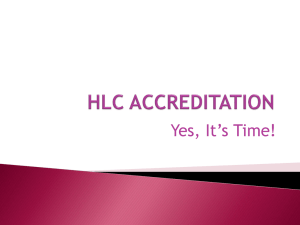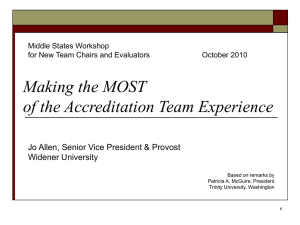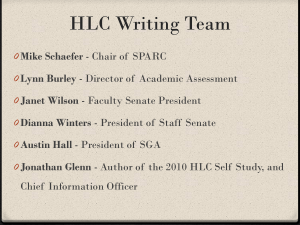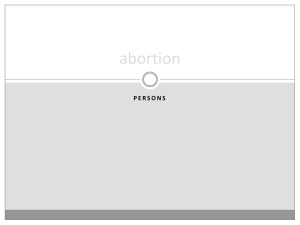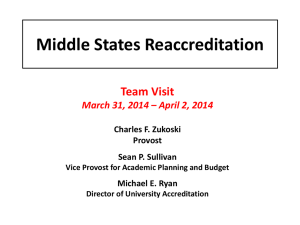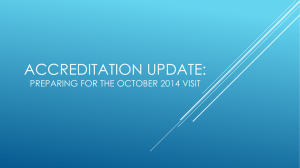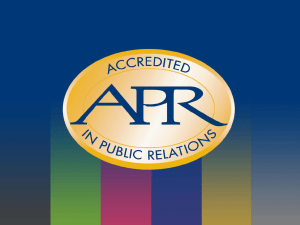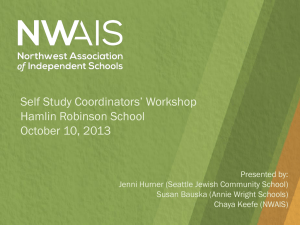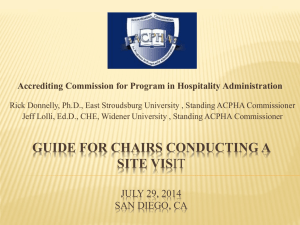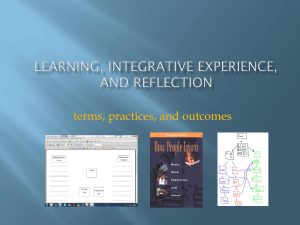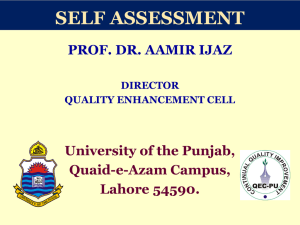Presentation #1 - University of Toledo
advertisement
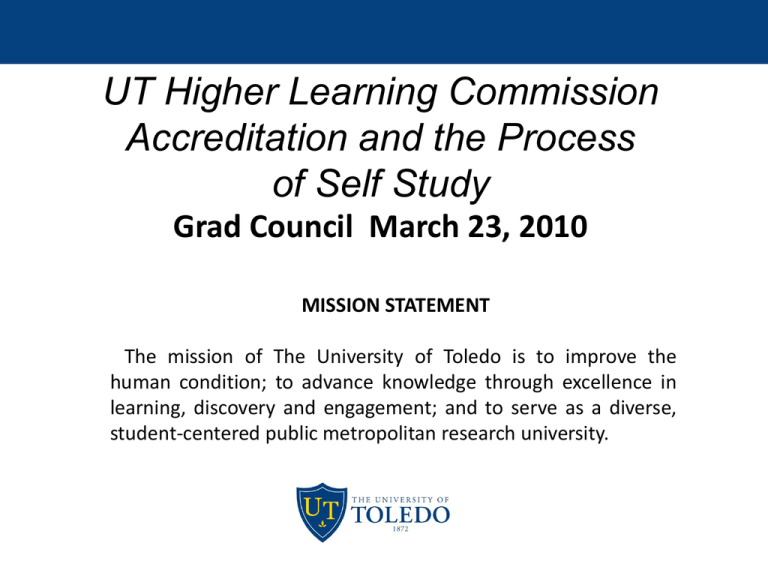
UT Higher Learning Commission Accreditation and the Process of Self Study Grad Council March 23, 2010 MISSION STATEMENT The mission of The University of Toledo is to improve the human condition; to advance knowledge through excellence in learning, discovery and engagement; and to serve as a diverse, student-centered public metropolitan research university. North Central Association and the HLC The NCA was founded in 1895 as one of six regional institutional accreditors in the United States. The NCA has two commission members: -The Higher Learning Commission (HLC) -The Commission on Public Schools (K-12) The HLC “accredits” by granting membership in the HLC and NCA to degree-granting educational institutions in the North Central region HLC is recognized by the US Department of Education and the Council on Higher Education Accreditation (CHEA). From J. Taylor, HLC 10/2009 2 NCA and the HLC The Organization – Member Institutions - ±1,015 – Location - in 19 States Decision-Making Processes and Peer Reviewers Corps – Board of Trustees - 15-21 Members – Institutional Actions Council - 26 Members – Accreditation Review Council – 170 Members – Peer Reviewer Corps -© 1,200 Evaluators **Includes 4 UT faculty (Drs. Ning, Edwards, Meabon, Suter) From J. Taylor, 10/09 3 What is accreditation? Accreditation is external peer-review to assess quality assurance and quality improvement. The process uses the University’s own self-study and planning for continued improvement. Our self-study is evaluated by HLC peer-reviewers and the outcome determines reaccreditation. Maximum possible is 10 years. Two types of accreditation: University wide evaluation: institutional accreditation Specific programs: specialized accreditation 4 Accreditation History The University of Toledo Medical College of Ohio 1922 – Accreditation granted 1972 - Approval by OBOR 1977 – Accreditation continued 1980- Accreditation granted 1983 – Accreditation continued 1986 – Accreditation continued 1992 – Accreditation continued 1991 – Accreditation continued 2002 – Accreditation continued 2001- Accreditation continued ****Feb. 27-29, 2012 – UT Site Visit 5 Self Study Timeline 2009 Aug: Oct: Oct-Dec: Criterion teams populated; teams begin meetings Self Study Kick-off; visit by Dr. John Taylor, HLC Teams work to identify evidence; Self study website 2010 Jan-Oct: Nov: Dec: Teams continue to work; Self-Study writing team selected Criterion teams submit first draft of their reports Drafts revised; writing team begins Self Study draft 2011 Jan-Aug: Sept: Oct: Nov: Dec: Finalize by iterative process of review/rewrite, campus review. Prepare for Institutional Snapshot and 3rd Party comment President/SL review/comment; campus review/comment President, senior leadership and BOT approval Final Self-Study revision, printing and 3rd party comments Send final Self-Study Report to HLC Feb 27-29, 2012 6 An Effective Self-Study • Evaluates the whole university - all undergraduate and graduate programs • Engages all constituencies • Builds on processes in place or identifies processes to add • Shows effective leadership and communication • Presents Evidence of Fulfilling the Accreditation Criteria • The findings of the self-study inform decision-making and future institutional development From J. Taylor 10/09 7 Previously Identified Challenges The University of Toledo 2002 Site Visit Medical College of Ohio 2001 Site Visit • No institution-wide, HLC • Strategic planning does not approved Plan for the drive decision making or have Assessment of Student measurable goals. Academic Achievement. • Scholarships are limited to the – Previously noted in 1992; School of Medicine. focus visit in 2005 approved • Campus lacks a cohesive plan for assessment. institution-wide student • Institutional planning process recruitment plan. does not clearly articulate and connect UT’s evolving mission, resource allocation, and measures of institutional effectiveness. 8 How were teams selected? How were team leaders and members selected? Self study is university-wide evidence gathering and evaluation, it is not college specific Team members--chosen from among those with knowledge & expertise in areas covered by Criteria and campus, rank, undergrad/grad programs, faculty, staff, student, fac-admin & to ensure gender/ethnic/racial presence. Total 78: faculty, 37% & fac-admin, 28% 65% with faculty backgrounds and 39 GRAD faculty (G) Size—hundreds with knowledge but to be most effective teams were set at 12-15 9 Criterion One: Mission & Integrity The organization operates with integrity to insure the fulfillment of its mission through structures and processes that involve the board, administration, faculty, staff, and students. • Do our public documents clearly express our aims and commitments? • Do they recognize diversity of learners, variety of our constituencies, and do they do so with the depth and inclusiveness needed to further our mission? • Does UT governance and administration further our mission by promoting needed leadership and collaboration? • Do all segments of UT perform in ways showing the grasp and endorsement of UT’s mission needed for our advancement? • Do all segments conduct work conscientiously so as to sustain the further advancement of its mission? 10 Criterion One: Mission & Integrity Dr. Charles Blatz, College A&S, Criterion One Team Leader Dr. Penny Poplin Gosetti, MC Provost Office, Liaison Criterion Team One: • • • • • • • • • • • • Defne Apul (MC) G Jeanne Brockmyer (MC) G Walter Edinger (HSC) G Barbara Floyd (MC) G David Guip (MC) Wayne Hoss (MC) G Saleh Jabarin (MC) G Kristen Kieth (MC) Susan Palmer (BOT) Carter Wilson (MC) G Bryan Yamamoto (HSC) G Student, Caitlin Kerr 11 Criterion Two Preparing for the future The organization's allocation of resources and its processes for evaluation and planning demonstrate its capacity to fulfill its mission, improve the quality of its education, and respond to future challenges and opportunities. a) b) c) d) Preparation for a future shaped by societal and economic trends Resource support for maintaining and strengthening education programs Evaluation and assessment processes show effectiveness and continuous improvement Planning levels align with the mission and the capacity to fulfill the mission. 12 Criterion Two Preparing for the future Mr. Bryan Pyles, Criterion Two Team Leader Dr. Bin Ning, Director, Institutional Research, Liaison Criterion Two Team: Lorinda Bishop (MC) Marcia Culling (MC) Bill Fall (BOT) Shandra Gore (HSC) Johan Gottgens (MC) G Brenda Grant (MC) Tom Gutteridge (MC) Dan Klett (MC) Kevin Kucera (MC) Brenda Lee (MC) William Maltese (HSC) G Bill McMillen (MC) G Andrew Meszaros (HSC) G Susan Pocotte (HSC) G Ellen Pullins (MC) G Student, Kystalyn Weaver 13 Criterion Three Student Learning & Effective Teaching The organization provides evidence of student learning and teaching effectiveness that demonstrates it is fulfilling its education mission. • Outcomes based education-goes beyond assessment plans and looks at how the results feedback to improve student learning and competencies • Core curriculum • Supportive environment • Alignment of resources with educational mission 14 Criterion Three Student Learning & Effective Teaching Dr. Constance Shriner, Criterion Three Team Leader Ms. Marcia King-Blandford, MC Provost Office, Liaison Criterion Three Team: Susan Batten (HSC) G Carol Bennett-Clarke (HSC) G Rob Bruno (MC) Tamara Clark (MC) Melanie Dusseau (MC) Terribeth Gordon-Moore (MC) Noela Haughton (MC) G Terri Hayes (MC) Anthony Koh (MC) G Patsy Komuniecki (MC) G Michele Martinez (MC) Ron Opp (MC) G Bruce Poling (MC) Jeannine Rajan (HSC) Barbara Schneider (MC) G Student, Michael Duran 15 Criterion Four Acquisition, Discovery & Application of Knowledge The organization promotes a life of learning for the faculty, administration, staff, and students by fostering and supporting inquiry, creativity, practice, and social responsibility in ways consistent with its mission. a) Demonstrates it values a “Life of Learning” b) Demonstrates the integral nature of knowledge and skill acquisition and intellectual inquiry c) Assesses the usefulness of curricula to students living and working in a global, diverse, and technological d) Supports responsible acquisition, discovery and application of knowledge 16 Criterion Four: Acquisition, Discovery & Application of Knowledge Dr. Charlene Czerniak, Criterion Four Team Leader Dr. Dorothea Sawicki, Professor, COM, and Co-Chair, HLC; Liaison Criterion Four Team: • Sherry Andrews (HSC) • • • • • • • • • • • • • • • Sonny Ariss (MC) G Jiquan Chen (MC) G John Greenfield (HSC) G Renee Heberle (MC) G Samir Hefzy (MC) G Ruth Hottell (MC) G Ken Kilbert (MC) Barbara Kopp-Miller (HSC) G Dan Kory (MC) Tom Kvale (MC) G Jolene Miller (HSC) Holly Monsos (MC) G Steve Peseckis (MC) G Mary Jo Waldock (MC) Student- TBD 17 Criterion Five: Engagement & Service As called for by its mission, the organization identifies its constituencies and serves them in ways both value. a) Learns from constituencies and analyzes its capacity to serve them b) Has the capacity and commitment to engage with identified constituencies and communities c) Demonstrates responsiveness to constituencies that depend on it d) Services are of value to internal and external constituencies 18 Criterion Five: Engagement & Service Dr. Mojisola Tiamiyu, Criterion Five Team Leader Dr. Thomas Sharkey, COB, Co-Chair HLC; Liaison Criterion Five Team: • • • • • • • • • • • • • • • • Jim Ferris (MC) G Charlene Gilbert (MC) Pat Hogue (HSC) G Morris Jenkins (MC) G Lisa Kovach (MC) G Barbara Miner (MC) Sudershan Pasupuleti (MC) Kelly Phillips (HSC) G Brian Randolph (MC) G Kathleen Salyers (MC) G Sabrina Serratos (MC) Tina Skeldon Wozniak (Community member) Christine Smallman (MC) Linda L. Smith (MC) G Steve Weathers (MC) Student, Brad Corlett 19 Special Emphasis: Goals “A Newly-merged University Looks To Its Future” • Identify untapped potentials that will propel the University to its next level while examining the remaining barriers holding the University to its former separate worlds. • Discover additional ways to advance the merger through strategic planning and deeper and broader systemic integration. • Lay a more solid foundation for UT to advance to the future. 20 Special Emphasis: Focus “A Newly-merged University Looks To Its Future” Merging Cultures - How to: • Move toward a shared identity that embraces mission and strategic plan • Translate cultures of a traditional research university and medical campus into one stronger institution Teaching and Learning Synergies - How to: • Move into greater interdisciplinary teaching and learning that advances UT’s commitment to excellence • Create balance between quality undergraduate teaching and research Economic Viability - How to: • Balance responsibilities to the USO with our mission and vision • Maximize intellectual capital as we streamline resources • Foster entrepreneurial environment that translates into new ways of teaching and learning 21 Outcomes of Site Visit Evidence criterion is met Evidence criterion met but needs institutional attention Evidence that criterion is met but requires institutional attention and commission follow-up (Progress/Contingency Reports /Focused visits) Criterion not met (even 1 of the 21 components) 22 What is my role in the self-study if I am not a team member? • Teams are responsible for gathering and assembling evidence to meet the 5 criteria. They will need to go to you to get evidence of research, teaching objectives and outcomes, service… Please assist this effort if you are asked for information/documents. • If you have an idea that would help, please contact the team leaders! Why is this important? • • • Institutional accreditation is important for all programs, especially those that do not undergo individual program accreditation. Accredited programs also need the university to have HLC accreditation. Individually program accreditation may not include accreditation of an undergraduate program. This provides evaluation of the undergraduate part. 23 How can I follow the progress of the self-study? 1. The website: www.utoledo.edu/campus/about/accreditation/index.html Email: UTSelfStudy@utoledo.edu 2. The draft of team reports are due Nov 2010. After review and drafting of full self study report, it will be posted for all UT members to read and comment. This is to allow you to tell us what else builds our case for the excellence of the University’s programs and how the strategic plan can help to support excellence in the future. And now, Dr. Shriner, HLC changes in assessment 24
